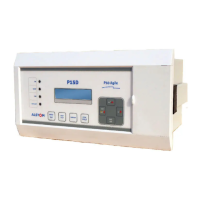Note: To prevent any possibility of electrolytic action between brass or copper ground conductors and the
rear panel of the product, precautions should be taken to isolate them from one another. This could
be achieved in several ways, including placing a nickel-plated or insulating washer between the
conductor and the product case, or using tinned ring terminals.
Current Transformers
Current transformers would generally be wired with 2.5 mm
2
PVC insulated multi-stranded copper wire
terminated with M5 ring terminals. The wires should be terminated with rings using 90º rings terminals,
with no more than two rings per terminal.
Due to the physical limitations of the ring terminal, the maximum wire size you can use is 4.0 mm
2
using ring terminals.
The wire should have a minimum voltage rating of 300 V RMS.
Caution: Current transformer circuits must never be fused.
Note 1: Terminal blocks must not be detached whilst any current transformer (CT) circuit is live. CT shorting
must be achieved by external means; the product does not include this facility.
Note 2: For 5A CT secondary, we recommend using 2 x 2.5 mm
2
PVC insulated multi-stranded copper wire.
EIA(RS)485 Connections
For connecting the EIA (RS485), use 2-core screened cable with a maximum total length of 1000 m or
200 nF total cable capacitance.
A typical cable specification would be:
• Each core: 16/0.2 mm
2
copper conductors, PVC insulated
• Nominal conductor area: 0.5 mm
2
per core
• Screen: Overall braid, PVC sheathed
There is no electrical connection of the cable screen to the device. The link is provided purely to link
together the two cable screens.
Output Relay Connections
These should be wired with 1 mm PVC insulated multi-stranded copper wire terminated with M4 ring
terminals.
USB Connection
The IED has a type B USB socket on the front panel. A standard USB printer cable (type A one end,
type B the other end) can be used to connect a local PC to the IED. This cable is the same as that
used for connecting a printer to a PC.

